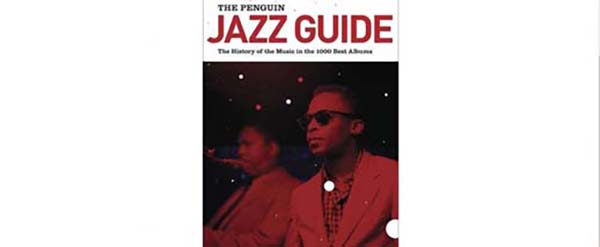
by Ian Mann
December 06, 2010
The latest edition of the celebrated Jazz Guide sees a significant change in format.
Book Review
The Penguin Jazz Guide-The History of the Music in the 1001 Best Albums
By Brian Morton & Richard Cook (Penguin Books)
Published just in time for the lucrative Christmas market the latest Penguin Jazz Guide represents a change in format and direction. Morton & Cook’s previous Penguin Jazz Guides were exhaustive and comprehensive guides to virtually all the jazz available on CD in the UK. The entire available output of any given artist was listed, from the masterpieces to the outright stinkers. The Guides weren’t cheap but they were superbly written-knowledgeable,witty, articulate and informative and for amateur critics such as myself they proved to be an invaluable research tool.
This latest edition is very different. Rather than representing a guide to the whole of the jazz spectrum the authors have selected the 1001 best albums in jazz history to date- therefore, by definition, all would have scored highly on the earlier Guides’ often contentious star ratings system. The authors have dealt with their selections in chronological order thus telling the story of the development of jazz (previous editions favoured an alphabetical A-Z listing of artists) with each decade being split into a separate “chapter”. The greater availability of recorded material from the 1950’s onwards has led to this and subsequent decades (with the exception of the current one) being further subdivided into “early” and “late”.
The change in format stems from the sheer amount of recorded jazz now available as record companies plunder their back catalogues at one end of the chronological scale while the self release phenomenon floods the market with fresh contemporary product at the other. It’s now physically impossible to listen to all the music out there let alone fashion an informed critical opinion in the time available. The unfortunate loss of Richard Cook to cancer in 2007 has also forced the abandonment of the previous format. Cook’s writing appears in this new volume, his presence is still highly tangible and Morton has insisted that this still be considered a work of joint authorship. To compensate for the loss of Cook Morton has invited the musicians involved to comment on their own work, or in cases where the protagonists have been unable or reluctant to comment he has used archive material or sought the views of fellow musicians and industry insiders, thus adding further illumination to the erudite summaries of the various recordings.
Morton and Cook write in an authoritative but conversational manner, a kind of “house style” that is readily discernible throughout the various editions of the “Guide”. Their knowledge of jazz, its styles and its musicians is encyclopaedic and this current edition encompasses all aspects of this now global music. Of course all the usual suspects are here with artists such as Duke Ellington, Miles Davis and John Coltrane appearing more than once across the decades. Morton and Cook utilise a handy cross referencing system to allow readers to put these famously changeable artists into context.
All the predictable but indispensable recordings are here (“Kind Of Blue”, “A Love Supreme” etc.-you all know what they are) but there are plenty of surprises too with the UK and Europe surprisingly well represented. British entrants include Tubby Hayes, Stan Tracey and, rather surprisingly Acker Bilk. There’s a comprehensive European presence too from Django Reinhardt through Jan Garbarek to E.S.T. But if those three names are to be expected there are plenty of less heralded figures too, and not all of them Scandinavian, a random sample might include Italian trumpeter Enrico Rava or Portuguese pianist Bernardo Sassetti.
Morton and Cook cover all aspects of the music from its very beginnings to the cutting edge of the contemporary New York “Downtown Scene” and write knowledgeably and authoritatively about all of them. They don’t appear to exhibit any particular bias to any given style or era and in a sense this is still an A to Z of Jazz with the cast list running from Louis Armstrong to John Zorn.
The new “Guide” is still an excellent work but I can’t pretend that I don’t miss the old format which made the previous editions such a valuable tool for research and reference. Nevertheless most readers will enjoy browsing through the new “Guide”, seeing which artists and recordings have made the cut and no doubt forming opinions about inclusions and omissions. I assume, for example that the absence of the seminal Loose Tubes was due to the lack of availability of any of their recordings at the time of writing-we’ve recently been treated to the emergence on CD of a live performance at Ronnie Scott’s from 1990.
One major omission from the new “Guide” is the lack of an alphabetical index. Previous editions indexed every musician featured in the book, right down to the humblest of sidemen. Given the new format it’s arguable that this would no longer be appropriate but an index of the leaders, at least, would make navigating the new book a lot easier. Perhaps the authors decided on this course of action to enhance the element of surprise when the reader stumbles across a totally unexpected recording, like the Acker Bilk referenced above.
Despite these reservations this is still a fine book, one of the best of it’s kind, and at a recommended retail price of ?20.00 it’s a good deal more affordable than previous editions. Just right for the jazz fan in your life this Christmas.
POSTSCRIPT 15/12/2010
Thanks to Sebastian Scotney’s London Jazz Blog I have today learned that the omission of an alphabetical index was in fact a publisher’s error. Penguin have announced that the index will be added to the second printing of the book, although the exact timing of this remains unclear.
blog comments powered by Disqus